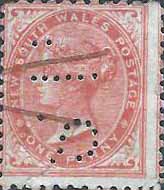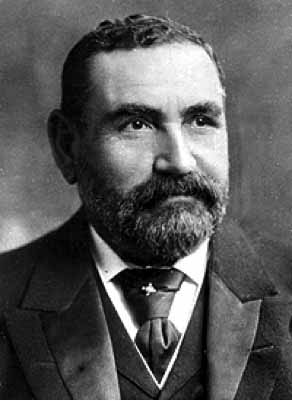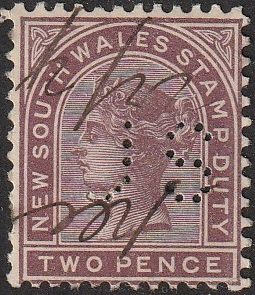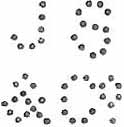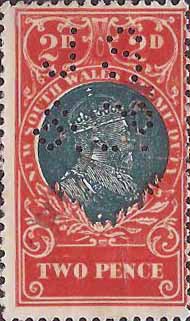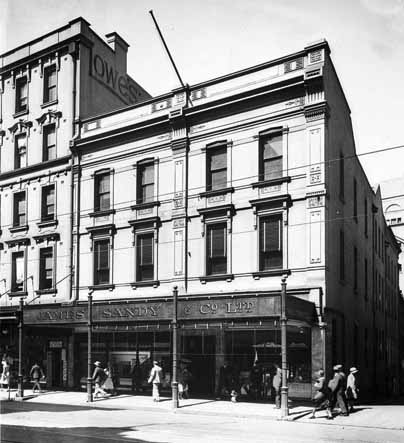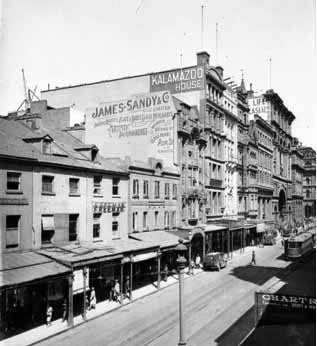|
Private Revenue Perfins of New South Wales An Elsmore Coath production The authors would welcome your comments additions or input into this work A B C D E F G H I J K L M N O P Q R S T U V W Y Other J -------------------------------------------------------- JS.a
User: John See & Co Address: 47 Sussex St, Sydney, NSW
Produce Merchants Revenue Use: 1880-02 2d 1882
fiscal issue 1d, 2d Rarity Scale 1880-02 2d R4 1882 fiscal issue 1d R4, 2d R4 Background: *John See (later Sir) was born on 14 November 1845 at Yelling, Huntingdonshire, England, son of Joseph See, farm-labourer, and his wife Mary Ann, (nee Bailey). The See family migrated to NSW arriving in Sydney on 16 October 1852. The family took up a farm at Hinton in the Hunter district, and by 1862 they had a property at Southgate on the Clarence River being farmed by John’s eldest brother David. John had been assisting his brother but after the floods of 1863 and 1864 (some sources 1868) he took a position working for George Nipper, a produce merchant and commission agent in Sydney, and later became a partner in the Company, Nipper See & Co. George Nipper was also an ex farmer from the Clarence River area and this gave them good relationships with farmers from that region and aided in their business success. This success was further aided by the companies purchase in the late 1860’s of some steamboats to assist in moving produce. Their fleet eventually grew to 14 vessels. The partnership with Nipper was dissolved in 1884 (some sources 1889) and John began trading as John See & Co. from Sussex St, Sydney. See built up agencies and stores at Grafton and Maclean as well a building a network of wharves, warehouses and offices along the Clarence and Manning Rivers to facilitate the collection and loading of produce. See’s fleet was later incorporated into the Clarence, Richmond and Macleay Rivers Steam Navigation Co. Ltd. with See as joint Managing Director, later known as the North Coast Steam Navigation Co. Ltd. From the 1880s he was a board member of a number of companies but he also became more involved in politics. In November 1880 See was elected to the Legislative Assembly for Grafton and held the seat until he retired in 1904. See served for a small time as Postmaster General and in 1891-1894 Colonial Treasurer and Minister for Railways and later between 1889-1890 as Colonial Secretary. See became NSW Premier in 1901 and in 1902 he was knighted but harsh economic times and a highly critical press placed See under heavy pressure which affected his health and he resigned in 1904. See died of heart disease on 31 January 1907.
John See c1900 Device: In all previous studies of Australian private perfins the JS device has always been stated to have been used by John Sands the Printers and Stationers from Sydney (and later National).
Presumably this was on the basis of some evidence, such as a postal proving cover showing the users name and an example of the perfin tied to the envelope, or similar. However in the latest update to HAPP, issued in February 2012, the editor reported that the user of JS was confirmed as John See & Co. He also stated that the previous user was now ‘doubtful’.
Now it is possible that there were two similar devices that produced a similar pattern, but this is unlikely, and is not supported by the strikes of JS we have seen which all appear to be the same.
On postage stamps carrying this perfin you will often find the numeral postmark ‘917’, which is the numeral for the King St Post Office in Sydney. This Post Office was located on King St, but down the Darling Harbour end near Sussex St and would have been the nearest Post Office to John See & Co and quite distant from John Sands & Co in George St. This supports the user as being John See & Co.
The JS.a device is a single die device and in joined pairs of stamps showing multiples strikes of the device there is no consistent relationship between strikes.
The JS.a pattern is found on the revenue stamps of NSW (rarely) but more commonly on the postage stamps of NSW and later Australia over the period 1886 until at least 1916.
If someone has an example of this pattern that provides evidence to the true nature of the user I would ask that you become a contributor to this site and share it.
Related Patterns: Nil
*Australian Dictionary of Biography
-------------------------------------------------------- JS.b
User: John See & Co Address: 47 Sussex St, Sydney, NSW
Produce Merchants Revenue Use: 1880-02 2d Rarity Scale 1880-02 2d R5 Background: See JS.a above-------------------------------------------------------- JS/&Co..a
User: James Sandy & Co Address: 326-328 George St, Sydney, NSW Also 271 George St, Sydney, NSW Glass Merchants, Wallpaper and Oil Importers, Contract Painters and Decorators Revenue Use: KEDVII 1909-28 issue 1d, 2d Rarity Scale: KEDVII 1909-28 issue 1d R4, 2d R4 Background: *The company James Sandy & Co was established in 1853 by James Sandy (Senior) as a retailer of plate and sheet glass, paints and paint products, paperhanging's and brush ware. By the 1890s, now under the management of James (Junior), James Montague Sandy, James Sandy & Co expanded their business and promoted themselves as contract painters and decorators and the company was responsible for the fit-out of numerous city buildings such as the Lyceum Theatre and the new 'Marble Bar' at the Tattersall's Hotel. In 1894, the company acquired the stock of the Australian Glass Company as well as their works at Boronia Street Redfern and became involved with silvering, beveling and glazing. At around this time James Sandy acquired a partner in Donald Cormack.
James Sandy & Co. 271 George Street James Sandy & Co had two showrooms in George Street (see above) as well as a glass department in Ash Street. The company was incorporated in 1909 and James was appointed Governing Director, a position that he retained until his death, on holiday in London, in July 1921.
The Sandy family retained management positions in the company with Harold Montague Sandy serving as Governing Director from 1924. Harold died in London in 1953 while still Chairman of James Sandy Pty Ltd as well as the associated companies of. James Sandy Industries Ltd, the Carter Paint Pty Ltd, and Wollongong Glass Co. The company was broken up in 1961 though the firm’s name continued to be used into the 1970s.
326-328 George St Device: The JS/&CO.a device was most likely a single die device and it came into service in 1911 and was used until about 1920. The commencement date of 1911 is shortly after the incorporation of the Company and this is consistent with best business practice at the time. The JS/&CO.a pattern is found on the postage stamps of NSW (rarely) and those of Australia as well as the revenue stamps of NSW. The device seems to have been sound throughout its short life and strikes are generally clear. Some late usage shows missing pins in the end of the J and the base of the S. Related Patterns: Nil *Trove *Historic Houses Trust -------------------------------------------------------- JS/S.a User: Justus Scharff (later Ltd) Address: 18 York St, Sydney, NSW Coastal and Island Traders Revenue Use: Unseen by the authors Rarity Scale: Background: *Justus Scharff & Co were Island Traders and competitors of Burns Philip in the South Pacific. Justus was of German decent and this became in time an advantage and a disadvantage.
The company are recorded as operating from Sydney from at least 1892 and the company was still trading in 1915. References to the company after WWI indicate that it was a Limited liability company but also refer to its owners (shareholders) being German, so it is possible that the company was floated in German. This change from Justus Scharff & Co to Justus Scharff Ltd most likely occurred in the early 20th Century.
Certainly the company grew in the early 20th Century and its increased involvement in coastal and island shipping and trading were made easier by the increased presence of German settlers and businesses in Papua, Marshall Islands, Samoa and other areas of the South Pacific. However the company’s activities were not limited to trade with German interests as they traded into French Polynesia, New Caledonia as well as the Solomon Islands and others.
The company’s German links were to be its undoing, as when WWI broke out, matters of cargo coming from former German Colonies became a problem for importers. This came to a head in May 1915 when the ‘Remonstrant’ arrived in Sydney from the Marshall Islands, with a load of copra consigned to Justus Scharff Ltd. On all reports the vessel had left the Jaluit Atoll, Marshall Island, prior to the occupation by Great Britain and therefore was essentially a shipment from Germany, or at least German interests.
The court decision in the matter was swift being handed down on 3 June 1915 and indeed it was very even handed, requiring the Australian Government to make payments to both the master of the ‘Remonstrant’ as well as Justus Scharff Ltd. However the tide of opinion was hardening towards German interests and although both Justus Scharff and key members of the company’s staff made representations about being British subjects the fact that the company itself was owned by German interests worked against it.
In late 1915 Justus Scharff and many of his staff were interned for the duration of the war. After the end of hostilities Justus Scharff Ltd made a series of lengthy legal challenges regarding treatment of the company’s affairs during the War. In particular debts that were owing to the company from various trades made before the war. These matters carried on until 1922-23 and the final decisions did not favour Justus Scharff Ltd.
The demise of Justus Scharff Ltd and fellow German trading company Lohmann & Co was in many ways the making of their competitor Burn Philip who came to posses a near monopoly in the region.
Device: The JS/S.a device was most likely a single die device as it was able to produce single central strikes on a range of stamp formats, including the larger format higher valued ‘diadems’ and ‘Coin’ postal issues of NSW. Furthermore multiple strikes of the pattern on adjoining stamps do not show any consistent relationship to each other.
The device came into use in 1893 and was still in use in early 1915 and it is found used on the postage stamps of NSW as well as those of Australia. Sydney postmark predominate.
The authors have not seen an example of a JS/S.a used on a NSW revenue but the usage was reported in HAPP (2003). The usage is entirely likely given the activities of Justus Scharff Ltd and similar companies such as Burn Philip used NSW revenue stamps.
Related Patterns: Nil
*Trove
*The Neglected War: 'The German South Pacific and the Influence of WWI' - By Hermann Hiery -------------------------------------------------------- A B C D E F G H I J K L M N O P Q R S T U V W Y Other © copyright 2011 |

